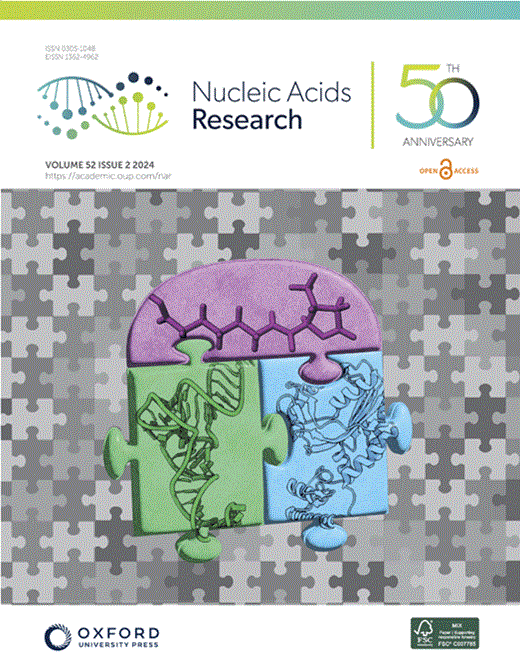Proximity-activated guide RNA of CRISPR–Cas12a for programmable diagnostic detection and gene regulation
IF 16.6
2区 生物学
Q1 BIOCHEMISTRY & MOLECULAR BIOLOGY
引用次数: 0
Abstract
The flexibility and programmability of CRISPR–Cas technology have made it one of the most popular tools for biomarker diagnostics and gene regulation. Especially, the CRISPR–Cas12 system has shown exceptional clinical diagnosis and gene editing capabilities. Here, we discovered that although the top loop of the 5′ handle of guide RNA can undergo central splitting, deactivating CRISPR–Cas12a, the segments can dramatically restore CRISPR function through nucleic acid self-assembly or interactions with small molecules and aptamers. This discovery forms the basis of an engineered Cas12a system with a programmable proximity-activated guide RNA (PARC–Cas12a) that links targets of interest to dsDNA. Leveraging the efficient trans- and cis-cleavage of Cas12, our findings further inspired a detection platform design for RNAs or non-nucleic acid biomarkers, enabling highly sensitive and multiplexed analysis. We further demonstrated the feasibility of RNA-controllable gene knockout/knockdown in Escherichia coli. Notably, we successfully validated the gene regulatory capabilities of the PARC–Cas12a system within mammalian cell systems by utilizing the classical theophylline molecule–aptamer system. Our results introduce a programmable toolbox for precise diagnostics and cell regulation, allowing the development of versatile diagnostic tools, complex synthetic biological circuits, and cellular biosensors.CRISPR-Cas 技术的灵活性和可编程性使其成为生物标记诊断和基因调控领域最受欢迎的工具之一。尤其是CRISPR-Cas12系统,已显示出卓越的临床诊断和基因编辑能力。在这里,我们发现尽管引导 RNA 的 5′ 柄顶环会发生中心分裂,使 CRISPR-Cas12a 失活,但通过核酸自组装或与小分子和适配体的相互作用,片段可以显著恢复 CRISPR 的功能。这一发现构成了工程化 Cas12a 系统的基础,该系统带有可编程的近端激活引导 RNA(PARC-Cas12a),可将感兴趣的靶标与 dsDNA 连接起来。利用 Cas12 的高效反式和顺式裂解,我们的发现进一步启发了 RNA 或非核酸生物标记物检测平台的设计,从而实现了高灵敏度和多重分析。我们进一步证明了在大肠杆菌中进行 RNA 可控基因敲除/敲除的可行性。值得一提的是,我们利用经典的茶碱分子-aptamer 系统,成功验证了 PARC-Cas12a 系统在哺乳动物细胞系统中的基因调控能力。我们的成果为精确诊断和细胞调控引入了一个可编程的工具箱,使多功能诊断工具、复杂的合成生物电路和细胞生物传感器的开发成为可能。
本文章由计算机程序翻译,如有差异,请以英文原文为准。
求助全文
约1分钟内获得全文
求助全文
来源期刊

Nucleic Acids Research
生物-生化与分子生物学
CiteScore
27.10
自引率
4.70%
发文量
1057
审稿时长
2 months
期刊介绍:
Nucleic Acids Research (NAR) is a scientific journal that publishes research on various aspects of nucleic acids and proteins involved in nucleic acid metabolism and interactions. It covers areas such as chemistry and synthetic biology, computational biology, gene regulation, chromatin and epigenetics, genome integrity, repair and replication, genomics, molecular biology, nucleic acid enzymes, RNA, and structural biology. The journal also includes a Survey and Summary section for brief reviews. Additionally, each year, the first issue is dedicated to biological databases, and an issue in July focuses on web-based software resources for the biological community. Nucleic Acids Research is indexed by several services including Abstracts on Hygiene and Communicable Diseases, Animal Breeding Abstracts, Agricultural Engineering Abstracts, Agbiotech News and Information, BIOSIS Previews, CAB Abstracts, and EMBASE.
 求助内容:
求助内容: 应助结果提醒方式:
应助结果提醒方式:


